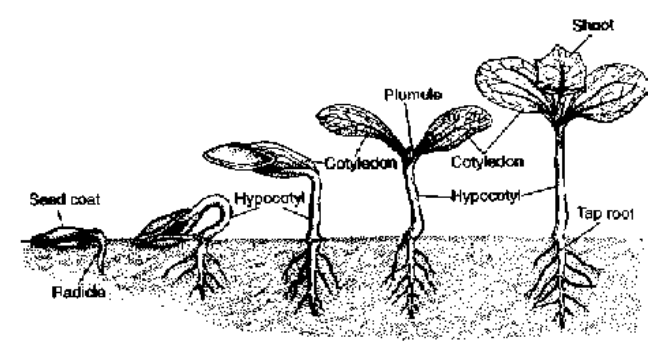Germination
Reproduction In Flowering Plants of Class 12
In germination are included all changes that take place from the time when a dry, viable seed starts to grow when placed under suitable conditions of germination to the time when the seedling becomes established on the ubstratum.
Conditions Necessary for Germination are as follows :
- External Factors
- Internal factors
- Water : Water is of primary importance in germination. A water-soaked seed will germinate; actual submergence may be harmful.When protoplasm absorbs water,seed resumes vigorous physiological activities. The embryo bursts through the seed coat which is softenedby imbibition of water. Water functions as a solventfor stored nutrient and also activates certain enzymes.
- Oxygen : In a germinating seed respiration and other physiological activities are more vigorous; hence oxygen is essential.
- Suitable Temperature : Seeds usually germinate between 0°C to 50°C and the optimum usually lies between 25°C at 30°C.
- Food and growth regulators : Food is necessary for growing embryo. This comes from cotyledons or endosperm. Some growth regulators are required forgrowth during germination.
- Completion of rest period : Many seeds do not germinate immediately after harvest but undergo a period of which varies from plant to plant.
- Viability : Viability is the germinating capacity of the seeds. Sometimes even perfectly viable seeds will not germinate even alter being provided with suitable conditions of germination. Such condition is called dormancy. It may be due to hard sead coat impermeable to oxygen or water or there may be a low temperature requirement or the embryo may be immature at the time of harvest, etc. When a viable seed which does not have any type of dormancy is provided with suitable conditions of germination, first there is swelling of the seed due to imbibition of water by seed coat. This caused bursting of seed coat ant radicle is the first organ to emerge through the micropyle and fixes the seed into the soil. After this either epicotyl or hypocotyl begins to grow. When the epicotyl grows first, only the plumule is pushed out of the soil,while cotyledons and all other parts remain under the soil. This is called hypogeal germination. However, if hypocotyl grows first, it pushes the cotyledons and other parts of the seed out of the soil. This mode of germination is called epigeal germination.

Fig. Epigeal germination

Fig : Hypogeal germination









